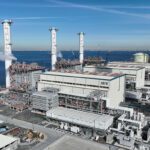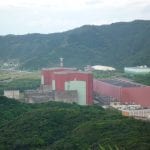JERA, Japan’s largest power generation company, has submitted a scoping document to begin assessing the environmental impact of its plan to add two gas-fired units at the Chita Thermal Power Station, while decommissioning five existing units at the facility. The company filed the report with government officials on March 16, with a 30-day public comment period expected to begin Wednesday.
The Chita plant, located south of Nagoya on Ise Bay in Aichi Prefecture, is undergoing a massive project that involves closing five of the facility’s existing six units, and the addition of two new combined cycle units that will be powered by liquefied natural gas (LNG). JERA, which produces about 30% of Japan’s electricity, operates nearly two dozen thermal power plants across Japan, utilizing LNG, coal, and oil as fuel.
The company also is developing renewable energy projects; the company on March 8 said it plans to build a 600-MW offshore wind project off the coast of Aomori Prefecture, near the towns of Tsugaru and Ajigasawa. The company previously has participated in offshore wind projects in the UK and Taiwan.
JERA, a joint venture of Tokyo Electric and Chubu Electric, also continues to build new coal-fired plants. Hitachinaka Generation, a JERA subsidiary, in January began commercial operation of the 650-MW coal-fired Hitachinaka Thermal Power Station in Ibaraki, north of Tokyo. The station uses an ultra-supercritical power generation system. JERA has said it “will continue to employ high-efficiency coal-fired power stations and develop decarbonization technologies as part of its efforts to maintain a stable supply of electricity and reduce CO2 emissions.”
Japanese officials last year said the country expects to bring about two dozen new coal-fired power plants online by 2025. Analysts, though, have said many of those assets would be at risk as investors increasingly move toward renewable power resources.
Decommissioning This Year
The Chita project, which was announced last fall, involves the decommissioning this year of Units 1 through 4 of the plant, which have been offline since 2017. Those units entered service between February 1966 and March 1974. The LNG-fueled units have total generation capacity of 2,258 MW. The 854-MW gas-fired Unit 5, which came online in March 1978, is scheduled to be decommissioned in 2026.
The LNG-fueled, 854-MW Unit 6 at Chita, which has operated since April 1978, is being retained. Two new 650-MW LNG-powered units are being added, with the current plan calling for those units to come online in 2027. The project when completed will leave Chita with three operating units with 2,154 MW of generation capacity. The decommissioned units have combined generation capacity of 3,112 MW. JERA has said its decision to revamp the power station is based on future electricity supply and demand, and the greater efficiency of the new units compared to those being retired.
The company in announcing the construction plan at Chita told POWER, “In order to reduce carbon dioxide emissions, for new units 7 and 8 the Plan adopts the latest high-efficiency combined cycle power generation system [with gross thermal efficiency of approximately 63%]. In addition, the environmental burden due to smoke and warm wastewater is expected to be lower than for operations at the existing facility.
“JERA will continue to move forward with the environmental impact assessment process under the guidance of the Ministry of Economy, Trade, and Industry and other related authorities, giving due consideration to the opinions of other stakeholders.”
Fossil fuels—coal, natural gas, and oil—account for about 80% of Japan’s electricity production, according to 2020 government data. Renewable energy, led by hydropower, accounts for about 16%. Nuclear energy provides the rest, but the country’s nuclear capacity has fallen as reactors were closed and decommissioned in the wake of the Fukushima disaster in 2011.
Japan’s “Basic Energy Plan,” set in 2018 and due for revision this year, calls for the country to receive about 56% of its electricity from fossil fuels by 2030, with as much as 24% of power generation from renewables. It expects the pace of nuclear reactor restarts will increase this decade, with nuclear supplying about one-fifth of the country’s power by 2030. Prime Minister Yoshihide Suga, who took office in September 2020, in October of last year announced a plan for Japan to be carbon-neutral by 2050.
—Darrell Proctor is associate editor for POWER (@POWERmagazine).










